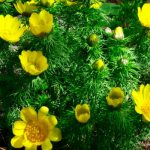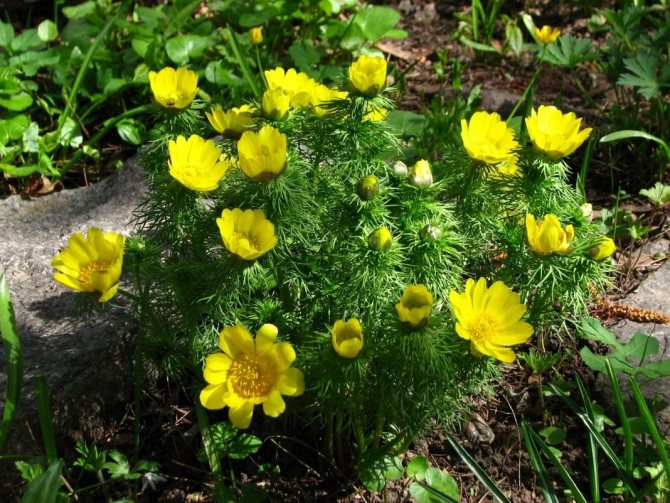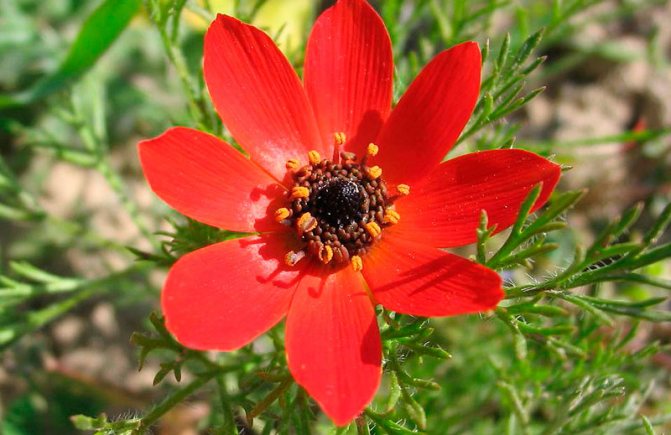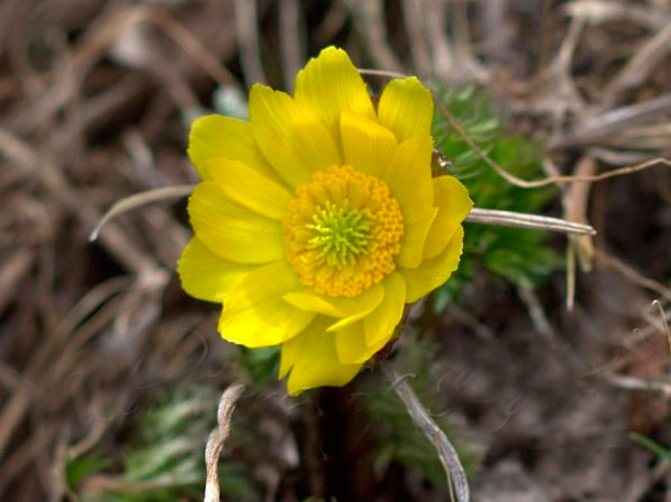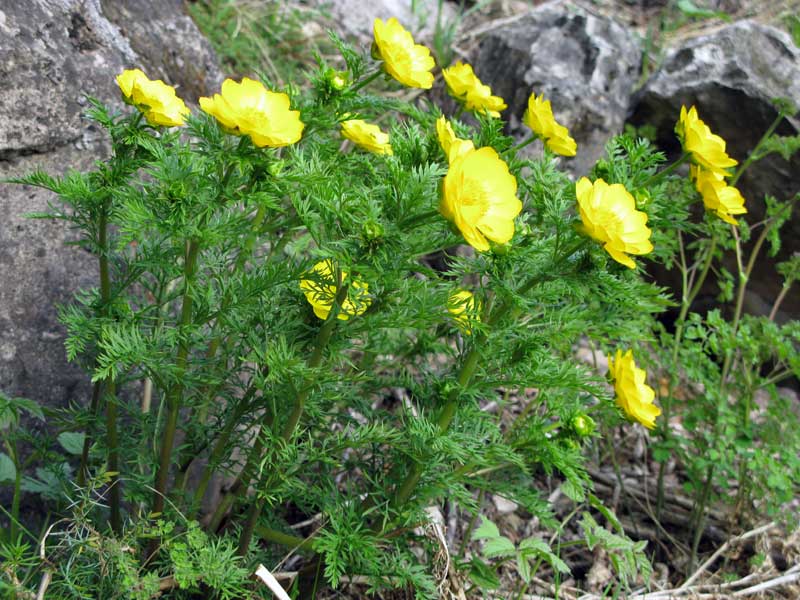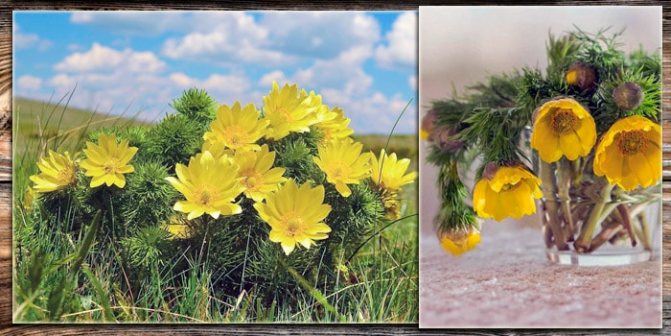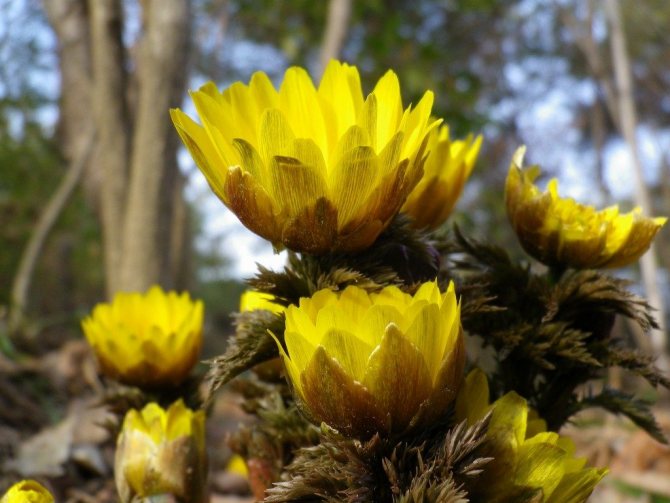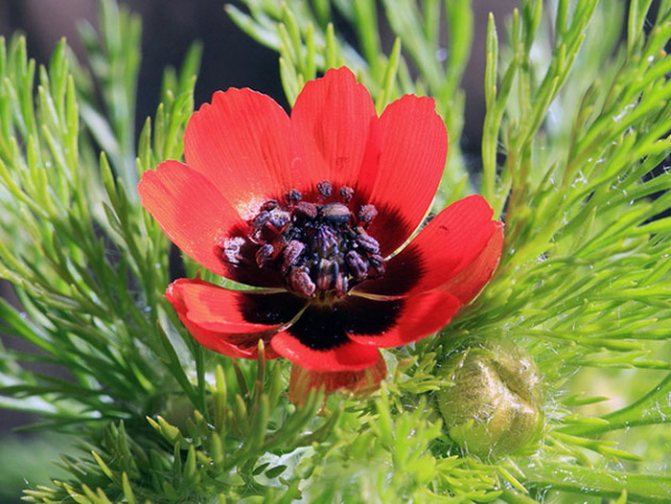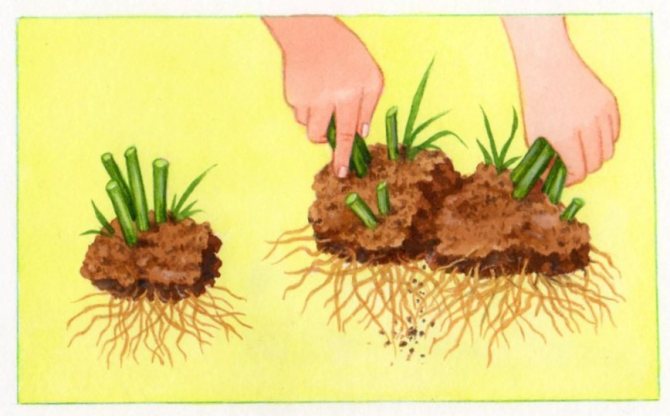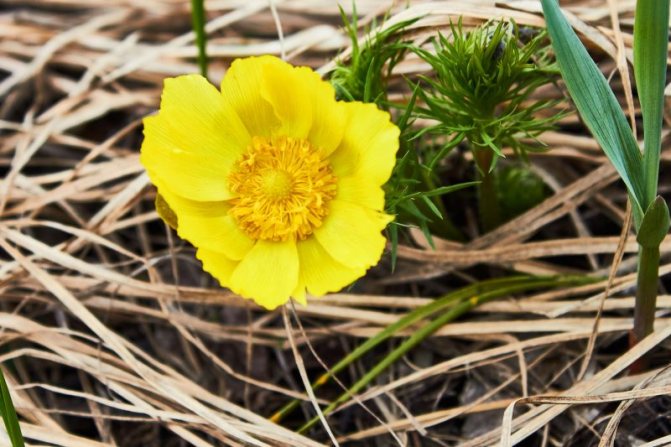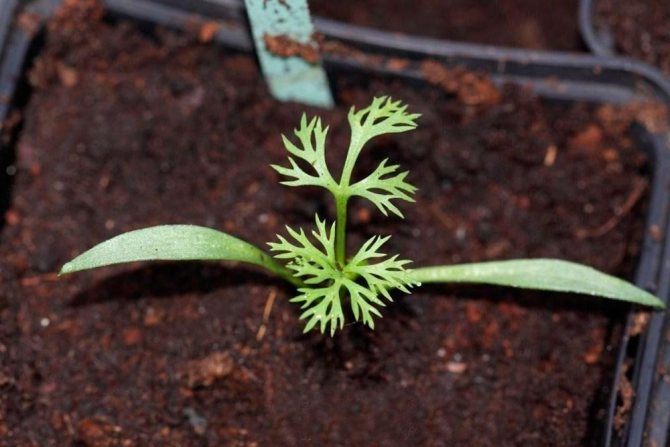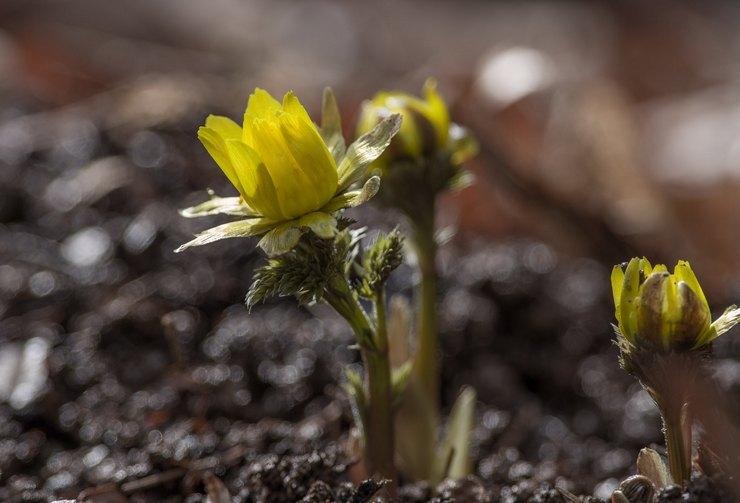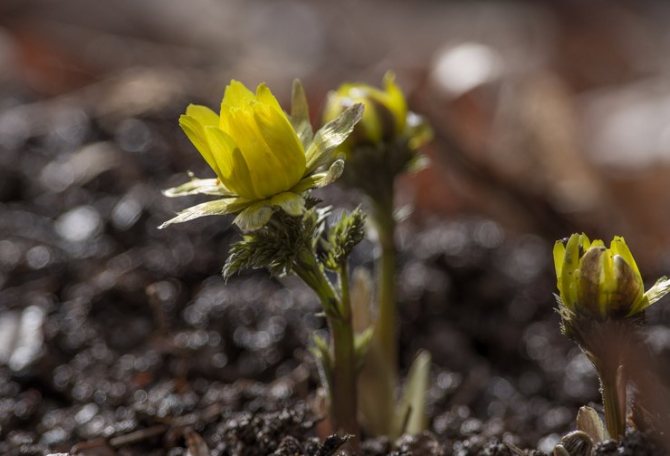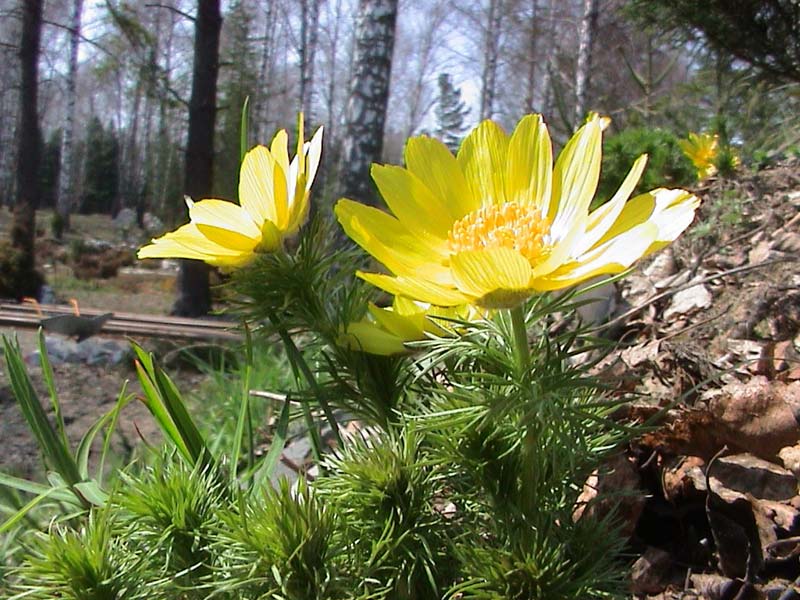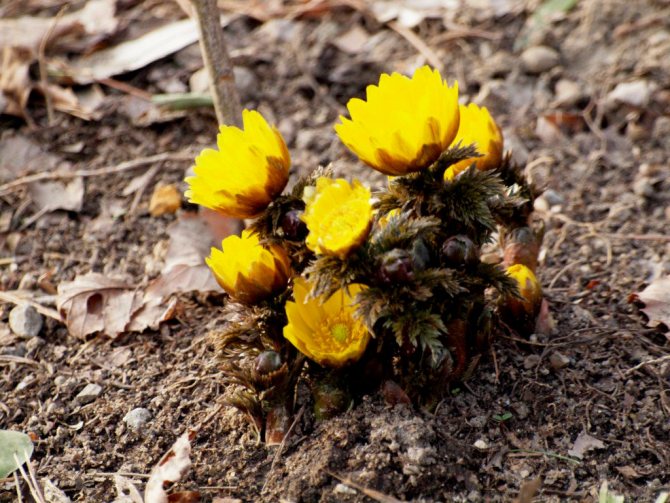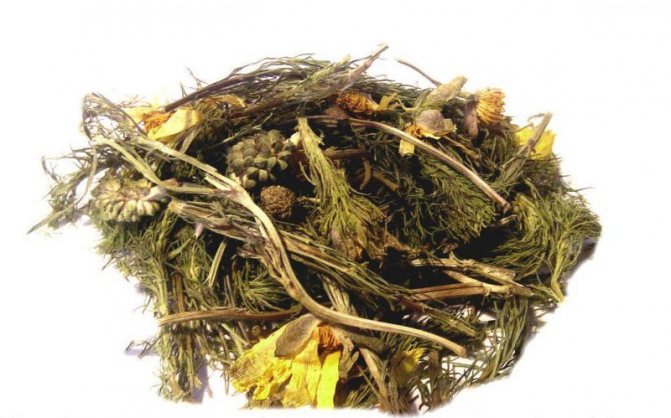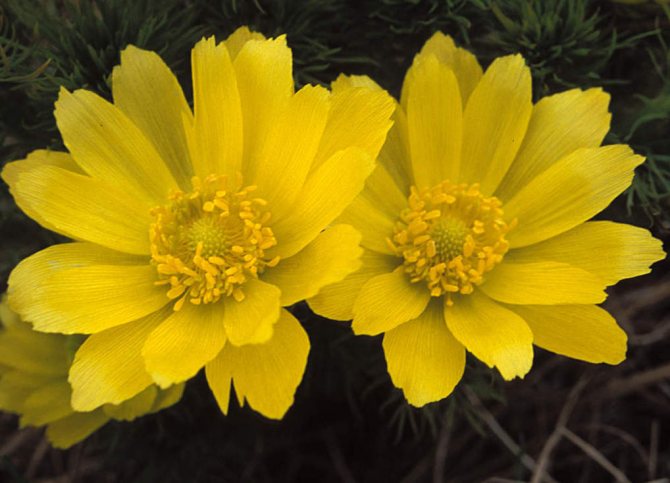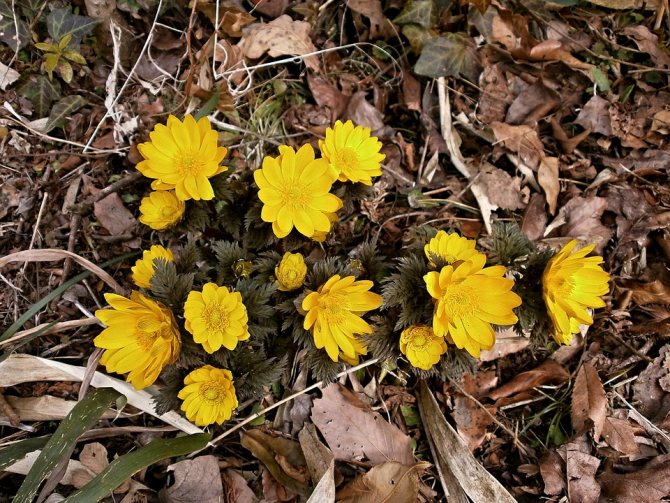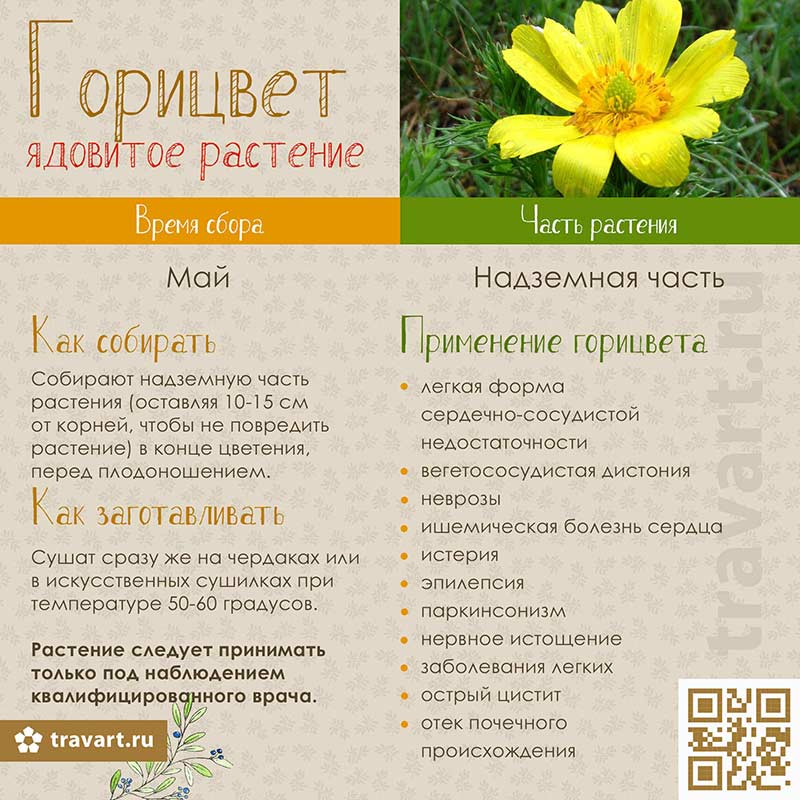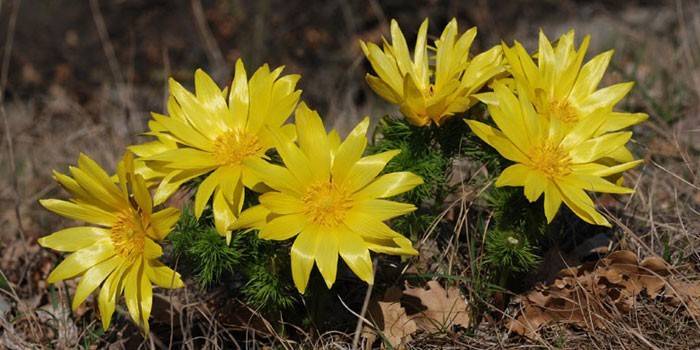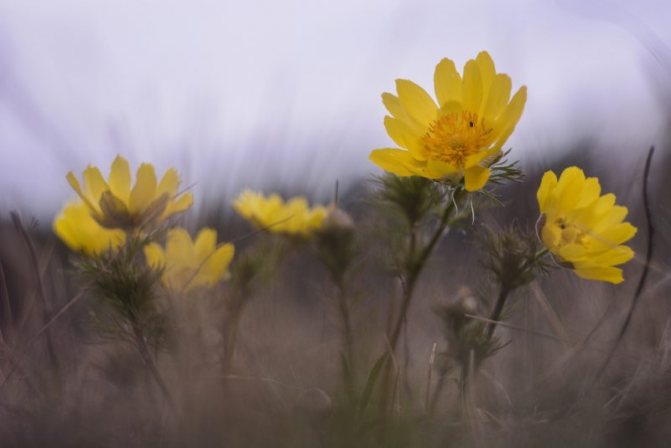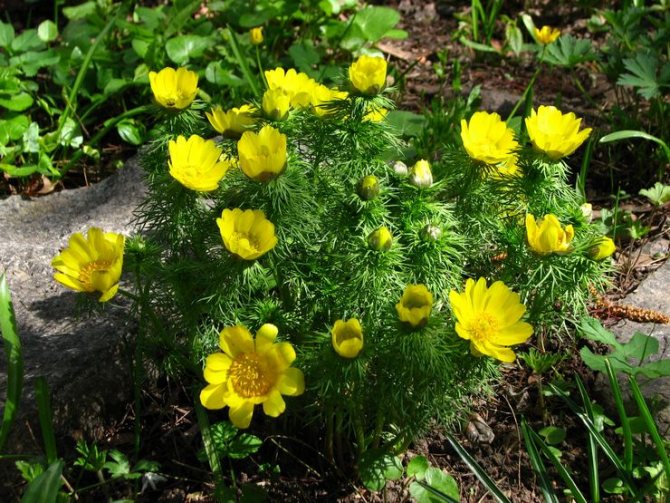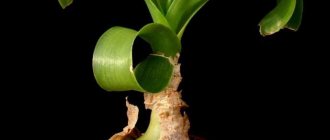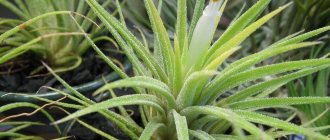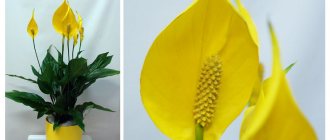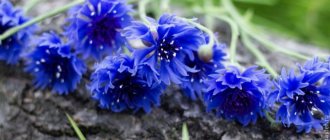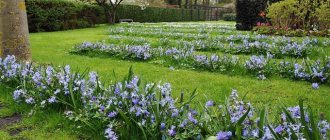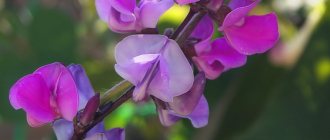A plant such as adonis (Adonis) is directly related to the genus of the buttercup family. According to various sources, this genus unites 20–45 species of different plants, which are represented by herbaceous perennials, as well as annuals. In natural conditions, they can be found in the temperate regions of Asia, as well as in Europe. Such a plant reacts negatively to heat. Adonis is a Latin name. So, this flower was named in honor of the son of the Cypriot king, if you believe the myths. Aphrodite fell in love with Adonis, but he died while hunting. The blood of the deceased young man stained all the flowers in a bright red color. In this regard, most likely this myth applies only to adonis, painted in red, but there are relatively few of them. But there is also another version. So, this plant was named after the Assyrian god Adon. Adonis became very popular with gardeners only at the end of the 17th century. Since that time, such a flower can be found quite often both in gardens, flower beds, and in parks.
Spring adonis - photo and description of the plant
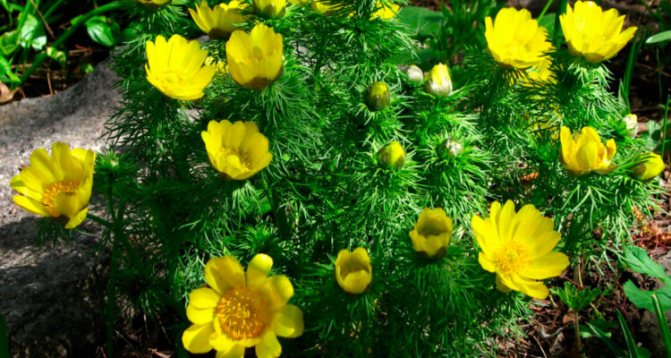
The appearance of adonis spring (adonis). A perennial brown plant grows vertically and has cord-like appendages. It has a smooth, rounded stem, on which leaves are densely located.
The erect shoot reaches a height of 20 cm before flowering and 40 cm after flowering.
The leaves, which are located in the root part of the plant, are scaly, have a brown tint. Upper leaves are palmate-separated with narrowly linear lobes.
This buttercup species has large single flowers that are located at the tops of the shoots. The average diameter of the inflorescence is 50 mm, in rare cases it reaches 80 mm. The flower consists of 15-20 oblong yellow petals. The plant blooms from mid-spring to late June.
Globular fruits consist of 30-40 nuts. Fruit length up to 20 mm. They ripen in the middle of summer.
I know, friend, you want to leave a comment!
A perennial herb from the buttercup family with a wide rhizome is often found under the name of spring adonis or adonis. Its stem is green up to half a meter in height, smooth with many branches. The leaves are very small, palmate-separated scales, densely covering the twigs, visually resembling dill. The flowering period is from May to June: bright yellow large flowers bloom at the ends of the shoots, in July fruits ripen - oval nuts. The wild adonis is found in the European part of Russia and various regions of Siberia, it feels comfortable in the steppe, forest and mountainous areas, there is an opportunity to cultivate it artificially. Folk and traditional medicine uses the entire aerial part of the plant. It is best to cut it off during the flowering period and before shedding the fruit. The finished raw material is almost odorless and has a bitter taste. Starodubka of natural habitat is listed in the Red Book.
Spring adonis - medicinal properties
Spring adonis has a tonic and immunomodulatory effect, increases the body's resistance to various infections.
The plant contains a glycoside such as cymarine. It has a beneficial effect on the nervous system and has a pronounced sedative effect.Infusion of spring adonis copes with insomnia.
Adonis helps to get rid of edema, as it exhibits an active diuretic effect. The plant can be found in kidney collections.
Most often, spring adonis is used as a remedy for the treatment of cardiovascular diseases. The cardiotonic glycosides, which are part of the plant, calm the heart rate and are indispensable in heart failure. Preparations based on adonis eliminate shortness of breath.
The glycosides that make up the plant are considered poisonous, but they do not accumulate in the body and are less active than, for example, in foxglove.
Adonis after flowering
Seed collection


Seeds are harvested after they begin to fall, but it is best to pick them a little unripe. It makes no sense to put them in storage. In this regard, it is recommended to mix them with moistened sand and sow in open soil.
Preparation for wintering
Such a plant is winter-hardy and does not need shelter. But this does not apply to the planted seedlings or to the cuttings planted in the autumn. They must be covered with peat, and spruce branches must be placed on top. After a year, they will be already strong enough and will be able to survive the winter normally without shelter.
How to collect
Procurement of raw materials is started in dry and clear weather immediately after the beginning of flowering. The stems of the plant are cut with a sharp knife or sickle at a height of 5-10 cm from the soil level.
It is strictly forbidden to pull out the grass along with the rhizome, so as not to ruin the plant population. The genus Adonis is considered rare, therefore, the procurement of raw materials is carried out no more than once every 4 years.
After harvesting, the plant is dried in a well-ventilated area, such as in the attic, or under a canopy outside. The main rule is that the raw materials should not be exposed to direct sunlight. The plant is dried at a temperature of no more than 40 degrees. Readiness is determined by the structure of the stem. If it does not bend, but breaks with a crunch, then drying is complete.
The plant is kept for no more than a year separately from other herbs, as it is poisonous.
Transplanting seedlings into open ground
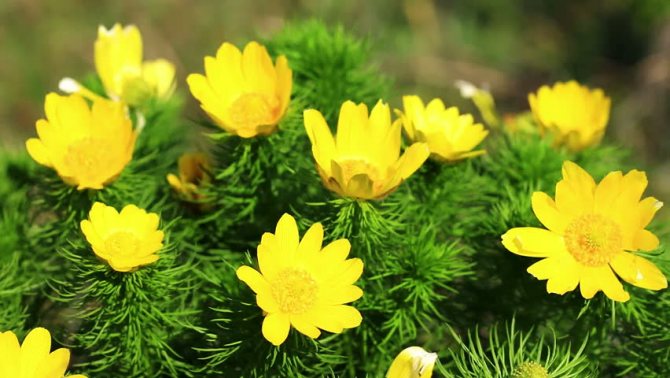

When to plant?
Grown and matured plants should be planted in open soil. So, this time can fall in April-May or August-September - it directly depends on when exactly the seeds sprouted. However, you should know that for successful wintering, plants need to root well, and this will take about 4 weeks. Adonis can be grown in a sunny or slightly shaded area. So, the plant feels best in such an area where the sun is shining in the morning, and at lunchtime it is in the shade. In the event that you want the flowering to be abundant, then the plants should be planted in drained light soil, which contains a lot of organic matter and lime. It is best if the pH is 7.0-7.5.
Disembarkation
A distance of 25-30 centimeters must be kept between the plants. The depth of the planting hole depends on the size of the plant root. So, it should be done in such a way that the root placed in it remains even, and is not bent. The planted plants must be watered, and the surface of the soil should be sprinkled with a layer of mulch (peat). But it should be remembered that the plant will definitely not bloom this year. Adonis belongs to slow-growing plants, while a flower of four or five years of age is considered a well-developed plant.
How to apply


Spring adonis is used in official and folk medicine for heart disease, insomnia and seizures. Spring adonis is used both as an independent medicine and in combination with other medicinal herbs. On the basis of dry raw materials, a soothing tea is brewed, infusions and decoctions are made.
Most often, adonis is used to treat disorders in the work of the cardiovascular system.Pharmacological drugs or infusions based on it calm the heart rhythm and eliminate edema, which are associated with disruption of the heart.
The main indication for the use of spring adonis is heart failure of I and II degrees, as well as heart neurosis.
The infusion of the plant has a beneficial effect on the central nervous system, has a sedative effect. It is often used to treat insomnia and nervous disorders, including hysterical conditions. In combination with bromine, the agent is used to treat epilepsy.
Due to its anti-inflammatory effect, spring adonis decoction is used to treat viral diseases - influenza, ARVI, scarlet fever. The tool has a tonic effect.
Spring adonis relieves pain in muscles and joints. The infusion of the plant is used to treat arthritis and rheumatism. In addition, adonis is effective as an anticonvulsant.
Infusion based on the plant normalizes urination. It is used to treat kidney disease, to relieve swelling and remove excess fluid.
Where Starodubka grows
Spring starodubka is found in the steppe and forest-steppe zones of the European part of Russia and in Siberia. It grows on forest edges, in meadows, on open slopes and in steppes, especially on limestones.
The spread of the old woman is quite significant. The northern border of its range almost coincides with the northern border of chernozem and runs from west to east.
In general, the Starodubka's range is a narrow strip strongly elongated from west to east and in this configuration includes a large number of areas with abundant plant growth.
For heart
To regulate the heart rate and in heart failure, an infusion of adonis is used in combination with other cardiotonic ingredients.
Infusion for the heart
Ingredients:
- Melissa - 5 gr.
- Adonis herb - 5 gr.
- Clover flowers - 5 gr.
- Motherwort - 5 gr.
- White mistletoe - 5 gr.
- Water - 800 ml.
How to cook: Mash dry ingredients, pour boiling water over and let it brew under the lid for 3-4 hours. Strain the cooled infusion through cheesecloth or a strainer.
How to use: Take a quarter cup after meals.
Result: Infusion regulates the heart rate, helps with increased anxiety. The agent acts as a sedative.
For insomnia
Alcohol tincture of spring adonis has a sedative effect and copes with insomnia.
Sedative
Ingredients:
- Adonis herb - 20 gr.
- Vodka - 200 ml.
How to cook: Place the adonis herb in a glass jar, fill it with vodka, cover and put it in a cool dark place. Leave for about 2 weeks, then strain.
How to use: Take 15 drops of alcoholic tincture of adonis three times a day, with or without food.
Result: The medicinal infusion soothes the agitated nervous system and normalizes sleep. Application of the product for 3-4 days completely relieves insomnia. After this, the drug should be discontinued.
Against seizures
Spring adonis has an anticonvulsant effect, including after taking picrotoxin and using drugs.
Anticonvulsant infusion
Ingredients:
- Adonis herb - 12 gr.
- Water - 350 ml.
How to cook: Pour dry adonis herb into a thermos, pour boiling water over and leave for 2-3 hours. Strain the finished product before use.
How to use: Take 1 tablespoon of the infusion 2-3 times a day after meals.
Result: The infusion normalizes muscle activity, eliminates cramps.
Growing adonis from seeds
Sowing
Seeds retain good germination for a relatively short time. In this regard, sow in open ground, freshly harvested seeds are recommended. Sowing should be done in November before winter, while they need to be buried by 1–2 centimeters.But this applies only to those species that are annuals. If the seeds are collected from flowers that are 6-7 years old or more, then their germination will be higher. In order for them to germinate, a temperature of plus 5 degrees is required. If you purchased the seeds from a store, then they must be sown in a greenhouse in early spring. For sowing, it is recommended to use a soil mixture consisting of sand (2 or 3 parts), sod land (1 part) and humus (1 part). The first seedlings can be seen after 14–20 days. Sowing of seeds of perennial species is carried out in the autumn, and for this, boxes are used, which must be filled with the same soil mixture. Then the box is removed to a cool place, and when it snows, it is placed under a snowdrift. The first seedlings will appear in spring after the air warms up to 20 degrees. However, there are seeds that sprout only after 12 months.
How to care for seedlings


Seedlings need bright lighting, but it must be diffused. Seedlings should be protected from direct sunlight. The plant also needs to be watered every day and gently loosened the surface of the substrate. The grown seedlings are thinned out if necessary. So, between them there should be a distance of 15–20 centimeters. However, if it is already April, then thinning may not be carried out, because soon the plants will need to be planted in open soil. The fact is that a transplant for Adonis is a lot of stress.
Spring adonis broth
Decoction of adonis is often used for hyperthyroidism (increased content of thyroid hormones). The remedy is prepared on the basis of spring adonis in combination with other medicinal herbs. The broth is prepared in a water bath and only over low heat, so as not to destroy the nutrients.
Spring adonis broth
Ingredients:
- Peppermint - 5 gr.
- Adonis herb - 7 gr.
- Cuckoo's adonis - 5 gr.
- Oregano - 7 gr.
- Chamomile flowers - 5 gr.
- Water - 1 liter.
How to cook: Grind dry ingredients with a rolling pin, fill with water and place in a water bath. Stir the herbs over low heat for 10 minutes. Cool and strain the broth. Store in the refrigerator for up to 2 days.
How to use: Take half a glass three times daily after each meal.
Result: The broth reduces the level of thyroid hormones, slows down metabolic processes in the body.
Caring for adonis in the garden


Growing
In order to grow a healthy plant, it must be watered often enough. In this case, the frequency of watering does not depend on the rate of drying of the soil surface. The resulting crust on the surface of the soil must be removed by loosening. Plants must be systematically hilled, as a result of the renewal buds must be covered with earth, and they are placed at the base of the stem. Adonis also needs to be fed with a full complex fertilizer, but this is done only if necessary. As a rule, feeding is done before flowering begins, as well as at the end of summer. For the first 2 years, experts do not advise cutting off the flowers that have appeared, since it is at this time that renewal buds begin to form, and in no case can they be injured.
Reproduction of adonis


Adonis can be propagated by the seed method (described above), as well as by dividing the bush. Only bushes of four or five years of age are suitable for division. If there is no need to divide the bush, then the transplant should be done 1 time per decade. Grow such plants on the same plant for two decades. You can divide the bush in August or in the first days of September. However, this can be done in spring, but only before the beginning of the period of active growth. The bush is carefully dug out, a very sharp knife is taken, and the root is cut into the required number of pieces.Roots and kidneys should be present on each section. Places of cuts should be smeared with a disinfectant, then they are planted in a permanent place. Since these are slow-growing plants, it is recommended to make the cut as large as possible. The fact is that small dealerships get very sick and, as a result, may die. It is necessary to care for the divided flowers in the same way as for young specimens. In the same year, flowers will appear on the bushes, but they will be very small. It is recommended to remove them so that the bush does not waste its energy on them.
Diseases and pests
Such a flower is very poisonous, therefore harmful insects, like pathogens of various diseases, bypass it.
Tincture of spring adonis
Infusion of spring adonis has a beneficial effect on the state of the central nervous system, has a calming effect. Infusions are prepared both in water and in alcohol (vodka). The use of infusions should be strictly according to the instructions and under the supervision of a specialist.
Depressant
Ingredients:
- St. John's wort - 5 gr.
- Melissa - 5 gr.
- Fireweed - 3 gr.
- Adonis herb - 3 gr.
- Rosehip fruits - 5 gr.
- Motherwort - 5 gr.
- Water - 500 ml.
How to cook: Mash dry ingredients with a rolling pin, grind the fruits in a coffee grinder, then combine with herbs. Pour boiling water over, cover and let it brew for at least 3 hours. Strain the cooled infusion.
How to use: Drink 2 tablespoons after each meal, no more than 4 times a day.
Result: The infusion soothes the nervous system and relieves increased anxiety.
You will learn more about the use of adonis spring (adonis) in the following video:
Composition and application of Starodubka
For medicinal purposes, the herb is used, that is, the aerial part of the old duck. It is used for the production of drugs used as a means of regulating and stimulating the activity of the heart. Starodubka's preparations have a number of advantages over other cardiac drugs, since they do not cumulate (do not accumulate) the force of action with repeated doses; they cause blood pressure to rise by increasing heart rate and narrowing of small arteries.
Glucoside is usually considered to be the active substance of the old duck. Recently, however, the effect of the herb on the body has been attributed to other substances, in particular, the glucoside cymarine, which was recently discovered in the herb of the old oak and has a great power of biological activity. Currently, standardized galenic preparations are produced from the herb, which are aqueous canned and ballast-free extracts. In pharmacies, tinctures and decoctions are prepared from the herb.
Recently, Starodubka tablets made from pure Starodubka herb or mixed with bromine in an appropriate dosage have begun to be used.
Among the medicinal plants used for heart diseases, the herb of the starodubka is universally recognized and in terms of the size of the need it occupies a large place. It belongs to the number of plants, the medical usefulness of which was first established in our country (the herb was introduced into scientific medicine in 1880 by Dr. Bubnov, who worked in the clinic of Professor Botkin).
Large consumers of Starodubka are factories producing the neogalene drug adonizide.
The dark brown, fibrous rhizome of the starodubka has the same medicinal properties.
It finds use in Siberia in folk medicine, as well as in some Western European countries. Harvesting rhizomes, however, is impractical, since they do not have any advantages in activity compared to the aboveground part, and their use will lead to the rapid destruction of thickets.
Starodubka
Spring adonis - contraindications
The use of drugs based on spring adonis should be strictly according to the instructions and under the supervision of a specialist.
Contraindications to the use of adonis:
- period of pregnancy;
- stomach ulcer;
- acute colitis;
- angina pectoris;
- duodenal ulcer;
- hypertrophic cardiomyopathy;
- children up to age 3 years.
In case of an overdose, nausea, vomiting, general weakness, arrhythmia, and drowsiness may appear. These symptoms are the reason for an urgent call to the doctor. First aid for overdose - gastric lavage and intake of activated charcoal.
Indications for use
The herb is referred to as cardiac glycosides and therefore is prescribed for ischemic heart disease, poor circulation, vegetative dystonia, heart failure, infectious diseases with a pronounced weakening of cardiac function, rheumatism, cardiovascular failure. Adonis helps with insomnia, neurological disorders, edema, kidney pathologies, cystitis, urethritis, epilepsy, convulsions caused by drug overdose. Dietary supplements are used as an adjuvant to the main therapy.
Varieties
The genus Adonis consists of 32 species of herbaceous plants. The most common ones are:
- Amur Adonis (lat.Adonis amurensis);
- Apennine Adonis (lat.Adonis apennina);
- Spring Adonis (lat.Adonis vernalis);
- Adonis Volga (lat.Adonis volgensis);
- Summer Adonis (lat.Adonis aestivalis)
- Adonis Turkestan (lat.Adonis turkestanica);
- Fluffy Adonis (lat.Adonis villosa).
Adonis spring infographics


Photo of adonis vernalis, its useful properties and application Infographics on adonis vernalis
Pharmacological properties
The plant was studied by N.O.Bubnov in 1880 at the suggestion of the physician Botkin. Its chemical composition contains a number of cardiotonic glycosides, the amount of which depends on the time of harvesting of spring adonis. In addition, the herb is rich in saponins, flavonoids, organic acids, carotene, vitamin C. Starodubka has a diuretic, analgesic, anticonvulsant, vasodilating, sedative effect. They help to slow down the heart rate, improve blood circulation. The drugs are produced in the form of tablets, amorphous powder, extract, aqueous infusions, alcoholic tinctures and dry preparations.
Preparing for winter
Perennial adonis flowers growing in one place for many years do not need shelter. Bushes winter well. For the first wintering, young growth and planted cuttings are thrown with dry peat with a layer of 10 cm or another type of mulch (rotted dry sawdust, straw, humus).
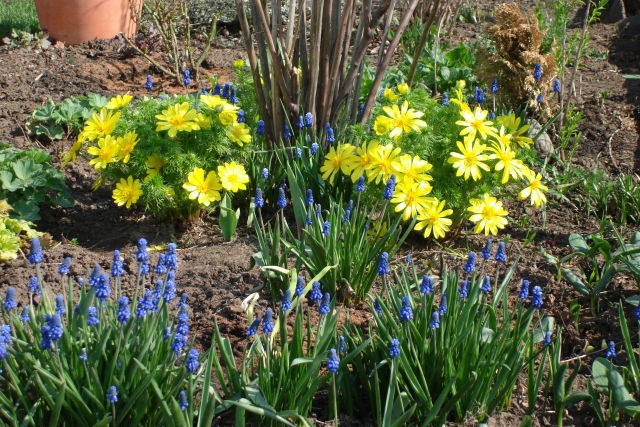

Adonis gets along well next to other perennials, the flower becomes a bright accent of the composition
Adonis has amazing buds - varnished bright petals, a dark core. Greenery looks decorative, the flower is planted in groups or singly on flower beds, lawns, alpine hills. They are used for decoration of plots and in landscape design.
The Legend of Adonis
The plant got its name in honor of the beloved goddess Aphrodite. Somehow Princess Mirra angered the beautiful goddess of love and sent terrible troubles to her, turning her into a tree. But when a child was born from the cracked trunk of this tree, Aphrodite could not restrain herself and kidnapped him. In a small casket, she took the baby to the underworld to Persephone and begged him to hide the child from prying eyes. But very soon the adorable baby conquered the heart and the wives of the gloomy Hades.
Persephone refused to return Adonis to the first beauty of Olympus. The angry goddess demanded Zeus restore justice. And he decided this: six months Adonis will live with Persephone, and six months with Aphrodite. Adonis grew up, turned into a beautiful youth and became the lover of Aphrodite. The jealous Ares could not bear this: he trapped Adonis hunting in the mountains and killed him, turning into a wild boar.
Aphrodite was inconsolable, mourning her beloved. From the drops of his blood, the goddess raised anemones, and at the very place where the lifeless body of her beloved fell, she commanded on the day of mourning to bloom a beautiful and delicate yellow flower every year, which people called adonis.
Collection of raw materials
In folk medicine, almost the entire plant is used, with the exception of the bare part of the stem: when harvesting raw materials, it is recommended to cut the plant from the middle, where the leaves begin to grow. The herb is harvested during the ripening or flowering season. The rest of the time, the healing properties are lost.
It is very important to dry adonis properly: tied in bundles in a ventilated, shady place. In no case should this be done in the sun. You can use the oven, oven. Ideal for drying temperatures from +40 to +50 ° C. Dried raw materials are stored for about a year in a ventilated area in paper or canvas bags.
Spring adonis is a very delicate and beautiful plant that can decorate a flower bed in your garden, cheer you up and, thanks to its medicinal properties, will help cure many serious diseases.
Spread
The annually increasing anthropogenic attack on the natural habitats of rare plants has also affected the spring adonis. It belongs to the Euro-Asian herb species included in the “alarming lists” by European botanists, and is included in the SITES list as a plant that tends to decrease in species abundance.
The flower's habitat stretches from the Pyrenees peninsula in the west to Yakutia in the basin of the river. Lena in the east, from the Baltic coast from the north to the Ciscaucasia in the south. It grows in the steppe, along the edges of deciduous forests, in the foothills, loves dry places. As a result of extensive plowing of the steppes, terracing of slopes and trampling, the number of populations is sharply reduced. The procurement of plants for the needs of medicine also has a significant impact. The low germination capacity of the herb does not contribute to the natural regeneration of the plant.
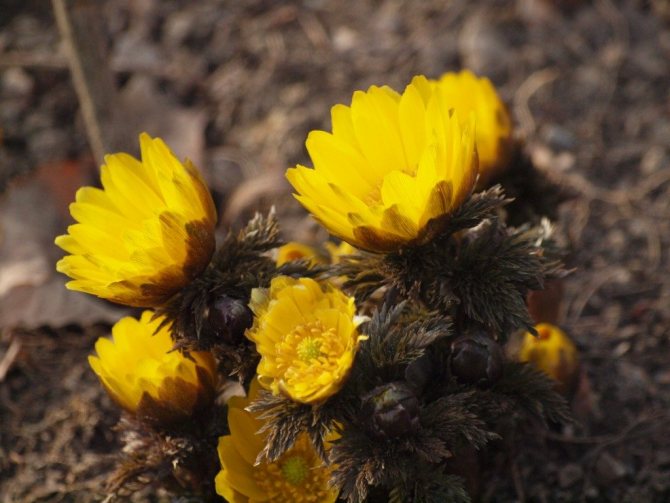

Adonis grows in the steppe, along the edges of deciduous forests, in the foothills and loves dry places
When to plant adonis
Young annual plants are transferred to a permanent place after recurrent frosts. Perennials can be transplanted until mid-autumn, because the shoots need to get stronger within a month before wintering.


The perennial Mongolian or Apennine adonis is recognized by its terry green core; on the basis of this plant, many beautiful hybrids have been bred
Expert opinion
Many doctors strongly advise caution in using natural adonis-based remedies. This statement is based on the fact that the plant has many potent substances in its composition, and if the dosage is violated, it turns into poison. And yet, the positive effect of the adonis as a calming, tonic and heart remedy can hardly be overestimated.
Phytotherapy specialist Natalia Y. Efimenko claims:
The herb adonis is a natural substitute for rather expensive drugs - glycosides. They are prescribed for the treatment of heart disease. But it is necessary to strictly observe its dosage.
Features of the cuckoo's adonis
The cuckoo adonis belongs to the carnation family. This medicinal plant has a completely different look and medicinal properties, and also grows in a different area. The cuckoo adonis is a perennial marsh plant that loves moisture. Its main pharmacological properties:
- hemostatic;
- antiseptic;
- anti-inflammatory.
It is widely used in gynecology: it stops uterine bleeding, helps with infertility. They are used to treat bronchitis, hepatitis, rheumatism, and kidney infections. For skin rashes, suppuration of wounds, abscesses, lotions are made from a decoction of cuckoo's adonis.
Spring adonis is a medicinal plant of the first choice for disorders of the heart. Cardiac glycosides contained in spring adonis have antiarrhythmic and cardiotonic properties. This remedy can be used alone or in combination with other medicinal plants. It is recommended to consult a doctor before starting treatment.
Brief botanical description
The plant reaches 25-60 cm in height. The stem is straight, smooth, round in cross section. Below it is covered with rare scaly-shaped leaves of a brownish hue, in the upper part it is densely leafy, with tightly pressed branches. Before flowering, it does not exceed 20 cm, then it begins to elongate and weakly branch. It reaches its maximum height during the period of seed ripening. Leaves are dark green, oblong, finely dissected, filiform, sessile. The root is short, upright, with thin, dark-brown processes resembling cords. After the onset of cold weather, it does not die off, giving fresh shoots every spring.
Single buds, 3–7 cm in diameter, juicy, sunny yellow. For this bright, catchy coloring, the grass was called the spring adonis. The calyx is pubescent with villi. The number of elongated petals bordered with small notches is from 12 to 20 pieces. Flowering time - from April to May, in the climatic conditions of Siberia and the Urals lasts until June. Each blossoming bud lives for 7-10 days, opening at dawn and closing in the afternoon. Flower formula * Ч5Л∞Т∞П∞.
The fruits look like shriveled, ball-shaped, obovate nuts, composed of 35–40 seeds. Each is 3-5 mm in size, has a hooked, curved column, covered with down. They ripen in June – July. The germination rate is low. The grass begins to bloom 5–15 years after germination, reaching its maximum development by 45–50 years. Belongs to honey plants. The flower is found in the steppes and forest-steppes of the Russian middle zone, in the Crimea, in the Caucasus, in the western regions of Siberia, in the Urals, in the countries of southern and eastern Europe.
Representatives of spring adonis are endangered species, protected by the state and included in the Red Book.


Login to the site


In the literature, a beautiful legend about the adonis plant is repeatedly mentioned, the Latin name of which is adonis. This legend was very popular in Ancient Greece, but reached its greatest fame during the Renaissance, when numerous paintings and sculptural works were created on the plot of the legend of Venus and Adonis.


The legend of Adonis is most fully described in Ovid's Metamorphoses.
According to one version of the legend, Venus was angry with the wife of the Cypriot king Kimir for disrespect and instilled in his daughter a passion for her own father. The king, not suspecting the truth and succumbing to temptation, entered into a relationship with Mirra, but, having discovered the truth, cursed her. The gods turned the unfortunate woman into a myrrh tree, with precious fragrant juice always oozing from her wounds. From the cracked trunk, a child was born, who was named Adonis. The boy was unusually handsome. Venus gave him to be raised by Persephone, the wife of the god of the underworld, Hades, on the condition that when the child grows up, he will return to her. But when the appointed time came, Persephone did not want to part with him. Zeus himself had to become the judge in this dispute, who decided that in the summer Adonis would live on earth with Venus, and in the winter he would return underground with Persephone. Happy Venus wandered through the forests with Adonis, begging him not to risk it and not to hunt ferocious beasts - bears and boars. But one day Adonis went hunting alone and died from the tusks of a wild boar. Venus bitterly mourned her beloved, and then turned him into a flower, sprinkling the young man's blood with nectar.
The graceful plot and the opportunity to show two beautiful human beings attracted the attention of artists already at the time of the legend. Plots about Adonis can be found on antique vases, frescoes in Pompeii, then in medieval miniatures. Scenes "Venus and Adonis", "Death of Adonis", "Venus mourns Adonis" you will see in the paintings of Veronese, Giorgione, Titian, Tintoretto, Rubens, Poussin and many other painters. The sculptors Kakova, Thorvaldsen, Rodin and others did not ignore this plot.
In European poetry and drama, Shakespeare, Lope de Vega, La Fontaine and “other writers have developed a story about the love of a goddess and a beautiful youth.
So what kind of plant grew from the blood of Adonis, what did the Greeks mean and what do the botanists think about it? Let's try to understand these issues.
The flower that grew from the blood of Adonis should most likely be scarlet in color.
In the foothills of Greece, as well as on all the islands and peninsulas of the European Mediterranean and in northern Africa, it is often found summer adonis (Adonis aestivalis) is an annual plant.
It grows like a weed among crops of grain crops. The height of this plant is about 20 cm. Stem leaves are repeatedly dissected into linear lobes. Flowers are solitary at the ends of shoots 2-3 cm in diameter. The flower consists of five green sepals and 6-8 fiery red corolla petals. Each of the petals has a black spot at the base. The flower has a large number of stamens with black anthers and many pistils. The nuts are collected in a complex fruit. Introduced in Europe, there are numerous varieties.
There are several more types annual adonis.
Most of these relatively small plants have dense red flowers that really look like drops of blood. So they were honored with the proud name of Adonis.
Scarlet adonis - summer, autumn, fiery can be found in Russia, in particular in the foothills of the North Caucasus, in the Krasnodar Territory and in the Stavropol Territory, they grow like a weed in crops and in preserved pieces of the steppe landscape.
Genus Adonis (Adonis), or adonis has about 45 perennial and annual species. And even if the color of the corolla in most species is not blood-red, all of them, in the understanding of botanists, are relatives of the "Adonis flower". Representatives of the genus live both on the plains and in the mountains, rising to 4500 m above sea level. Due to their habitation in hard-to-reach areas, many species remain poorly studied to date.
We have already talked about annual species. Let us now dwell on the most studied perennial species.
First of all it is spring adonis (Adonis vernalis), adonis. It is a plant of the steppes of the European part of Russia, Crimea, Ciscaucasia, Siberia, as well as Central and Southern Europe.
Spring adonis is a component of the forbs of meadow steppes and steppe meadows. It is one of the most beautiful plants, with golden flowers that bloom in late April and ends in late May-early June. The lower leaves are scaly, stalk-embracing, the stem leaves are sessile, repeatedly dissected.
A large flower up to 6 cm in diameter, consisting of 15-20 free yellow, shiny petals supported by five pubescent sepals, is located at the top of the stem. There are many stamens and pistils. The height of flowering plants is 10-15 cm, fruiting, 40-60 cm. Fruits are wrinkled with a hooked spout, ripen in July. The fruit is a composite of numerous dry nuts - many-nuts. Spring adonis in Europe introduced into culture. There are garden forms.
| Adonis golden (Adonis chrysocyathus) is one of the rare plants in Central Asia. This herbaceous perennial is an extremely valuable medicinal and ornamental plant that is found in the Tien Shan, Kashmir, Western Tibet, where clumps of adonis create colorful bright yellow spots on rocky mountain slopes. The shine of yellow is especially expressive against the background of the snow that has not yet melted and the blue of the alpine sky. A limited number of localities of this species are known, and the population size is constantly and significantly decreasing due to human intervention. The aerial part is represented by one or a group of semi-rosette shoots, the number and size of which depend on age. So, a middle-aged individual has up to 30 rosettes 45-50 cm high. A generative shoot, as a rule, has a single large bright yellow flower.The shoot is equal to or slightly higher than the height of rosette leaves. |
| Adonis Turkestan (Adonis turkestanicus) - one of the valuable medicinal plants of Central Asia - endemic to the Pamir-Alai. The main part of its range is associated with the mountain systems of Gissar-Darvaz, where it can form continuous thickets in juniper and tragacanth forests at an altitude of 2000-3500 m above sea level. The cleanest thickets were found in the places of the former perennial cattle camps. This indicates a positive attitude of plants to organic-rich soil. Turkestan adonis at the beginning of flowering has a height of 10-20 cm, and during the ripening period of fruits up to 70 cm. The whole plant is covered with curly hairs. Flowers at the ends of the shoots are single, 4-6 cm in diameter, the perianth is double, regular, consists of a corolla and a calyx. Petals are yellow-orange, bluish on the underside. A characteristic feature of this species is that at the same time the plant has just formed buds, opened flowers and set seeds. |
Adonis Mongolian (Adonis mongolica) is an endemic plant in Mongolia. Occurs within the Khangai, in the mountain and meadow steppes, along the edges of larch forests. It is most abundant at the sites of old cattle camps. Grows on loose, humus-rich soils.
Mongolian Adonis is one of the early spring plants in Mongolia. It is difficult to imagine a brighter and more beautiful picture - the caps of snow-white flowers on the steppe slopes with last year's brown foliage against the background of a bright blue sky. Flowering begins in April-May, and massive blooms in late May and June.
Here it is appropriate to recall the sharp continental climate of Mongolia, especially its mountainous regions, when, during the growing season, sharp temperature fluctuations are possible up to frost, snow and hail. Leaves unfold following the blooming of flowers. Shoot growth continues until the seeds ripen. The herb of Adonis Mongolian serves as a raw material for obtaining valuable cardiac glycosides.
Adonis amur (Adonis amurensis) is a perennial herb from the Far East, where it grows in cedar-deciduous forests. Leaves are pinnately dissected on long petioles, develop after flowering and persist until July and August.
Blooms from April for 2-3 weeks. The flowers are golden yellow, wide open, up to 5 cm in diameter. Blooms until leaves appear. Plant height during flowering is no more than 10-15 cm. Fruiting in late May and June. Propagated by seeds. Seedlings appear in a year.
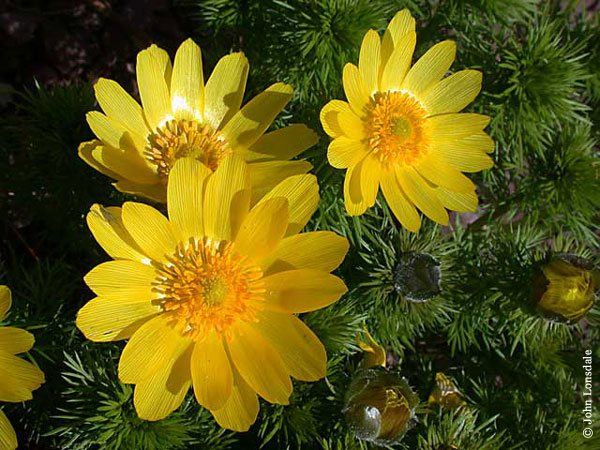

The plant has been introduced into cultivation.
In Japan, numerous decorative varieties with double flowers of white, pink, red color have been bred.
Plants blooming in early spring always attract attention, they are touching and beautiful against the background of last year's dark foliage. All species of the genus Adonis - early flowering plants... They are extremely decorative, forming lush "bushes" with numerous bright flowers.


Unfortunately, their slow development inhibits their spread in culture as ornamental and medicinal plants. Numerous attempts to introduce adonis into culture have shown that this process is long, laborious and not always leading to positive results. However, at present, 10 species of the genus Adonis are grown in botanical gardens in Russia and in neighboring countries.
Perennial species reproduce seeds... Seedlings can appear in the second, third and even fifth year after sowing (golden adonis). Consequently, all this time, weeding and watering of the sown area is required as the soil dries up. Perennial plants can be propagated by dividing the curtain. Share you can middle-aged individuals. Old copies will not give positive results when dividing. Division should be carried out in late summer, early autumn, so that the plant successfully rooted before winter. All adonis prefer light soil, rich in organic matter and lime, do not tolerate drying out and excessive moisture.
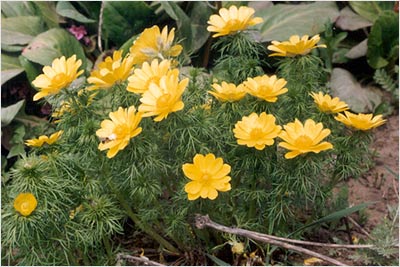

Annual species propagated by seeds, the optimal sowing time is late autumn. Seedlings need to be cut into light soil rich in organic matter and preferably shaded.
Adonis decorative in the form of single curtains. They have been growing in a permanent place for more than 10 years. Small slides can be a good landing site. Group plantings in combination with low-growing evergreens are also spectacular.
Combinations of adonis with other early flowering plants, such as lumbago, woodlands, poultry, hazel grouses, primroses are decorative. Irises, bells, onions, thymes, phloxes, violets and others can be recommended as components in group plantings.
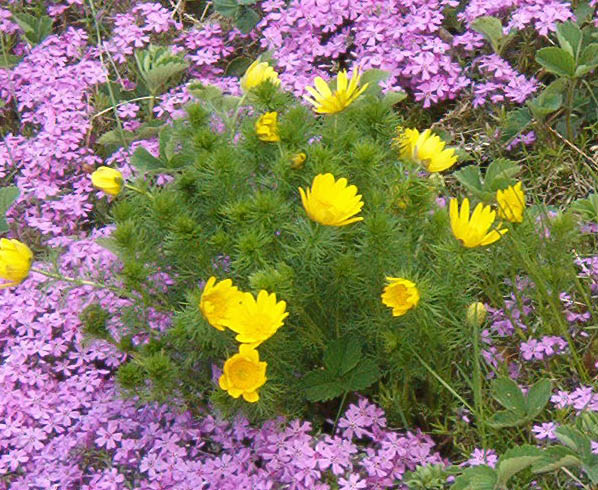

Perennial species of adonis are very ancient plants that first appeared in southeast Asia even before the rise of the mountains of Tibet and the Himalayas, develop very slowly. Even under cultural conditions, when the plant grows faster, the spring adonis blooms for 3-4 years, and in nature - for 6-7 years.


The fastest growing perennial species of the adonis, just those that have a blue and white color, reach their maximum development at 25-30 years. Golden adonis growing in the Tien Shan mountains begins to bloom in 30-40 years. But on the other hand, these herbs are distinguished by enviable longevity. The already mentioned golden adonis lives longer than many large trees - up to 300 years!
Sources of
Natalia TRULEVICH "Adonis or adonis" // "In the world of plants" - 2004 - №4.


Dear readers, do not forget to vote!
Application in official medicine
The herb extract is used in the production of pharmaceuticals. To avoid complications and unwanted side effects, they should only be taken with the permission of the attending physician. Pharmacies sell the following products with herbal extract:
- "Adonizid" in ampoules, drops, tablets, is used for vegetative-vascular disorders;
- "Cardiovalen", aimed at combating neuroses, heart failure, insomnia;
- pills "Adonis-brom", which have a cardiotonic and calming effect;
- drops "Cordiazid", which improve blood circulation, stimulate the heart;
- liquid medicine and ankylosing spondylitis tablets with a sedative, anticonvulsant effect;
- alcoholic herb tincture;
- herbal cardiac and renal combined fees;
- dry extract of adonis in the form of a brownish-gray powder.
Spring adonis is also a part of complex heart preparations. A number of agents, including "Kordiazid", are used in veterinary practice to normalize blood circulation, cardiac activity, eliminate edema and functional congestion, and dissolve exudates.
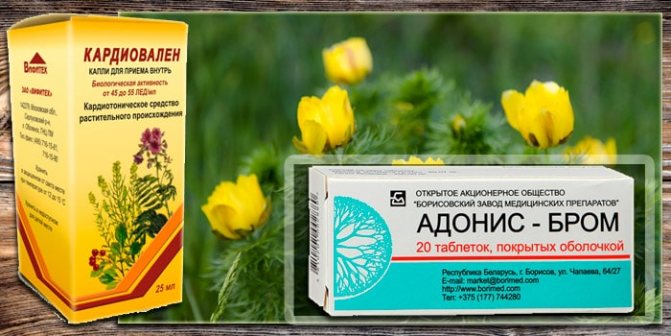

Chemical composition
All parts of the plant are toxic and, if used carelessly, can cause poisoning. Adonis contains the following bioactive substances:
- about 20 glycosides of the cardiac group, which include adonitoxigenol, cymarin, K-strophanthin, adonitoxin;
- flavonoid compounds, saponins;
- phytosterol, adonit (pentahydric alcohol contained in riboflavin);
- natural organic acids, vitamin C;
- mineral components, including chromium, manganese, calcium, iron, potassium;
- alkaloids, tannins;
- vernadine is found in the rhizomes.
The main active ingredients are glycosidic compounds, the maximum concentration of which is noted in leaves and green nuts.
Diseases and pests
It is rarely affected by harmful insects. Thanks to the poisonous juice, pests do not favor flowering shrubs with their attention. Most often, problems during cultivation occur with the creation of good lighting and rotting of the roots.
In poor light conditions, adonis may shed flowers or not set buds at all.If the plant begins to bloom and it begins to lack light, the buds may not open.
With irregular watering, the leaves of adonis can turn yellow and fall off. But rotting of the roots is much more terrible for him, so it is necessary to develop an optimal irrigation regime so that the earthen lump is moderately moist.
Reproduction of the adonis flower
There are two ways to propagate adonis. The first is seedling, the second is the division of the bush. The seedling method is disclosed above.
The division of the bush can only be applied to adult adonis (over five years old). For this type of breeding, the appropriate time of the year is autumn, early September. You should carefully dig out the root and divide it so that each part has at least two buds and roots. It is recommended to divide the roots into large parts. The cut site is treated with a disinfectant, and all parts are immediately planted in the soil.

